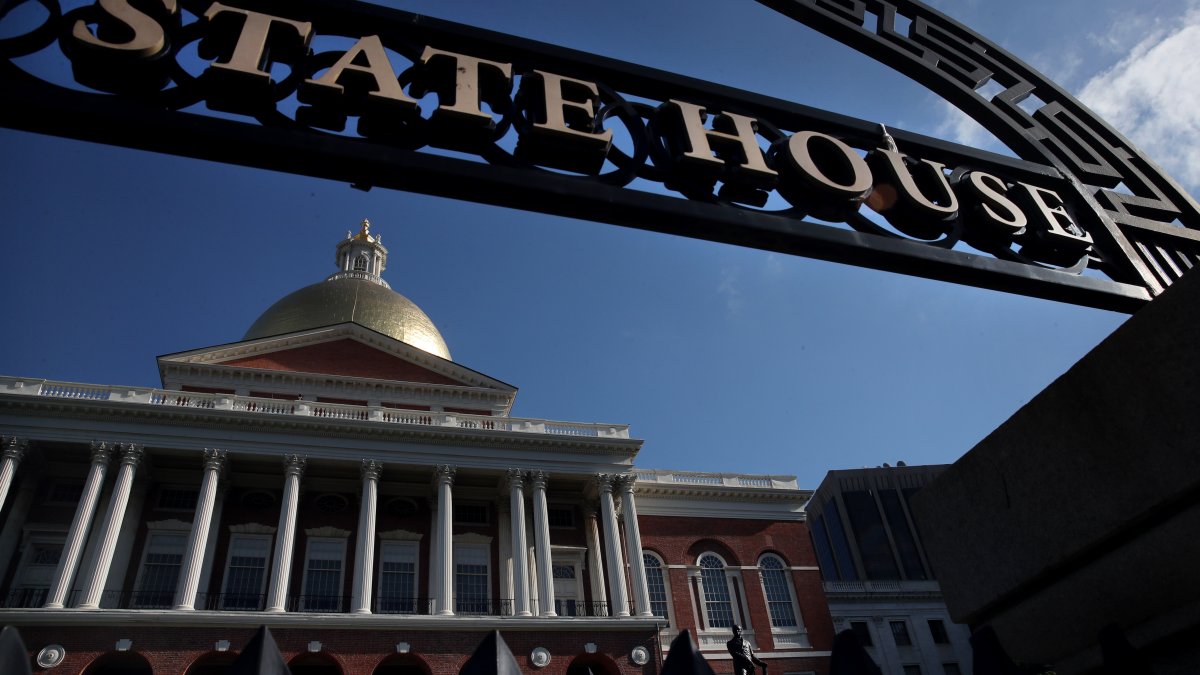Business
Column: GOP thinks the court orders they used against Biden should be outlawed — because they now target Trump

The old political adage that “where you stand depends upon where you sit” has been getting aired out in Washington.
Republicans and conservatives used to celebrate judges’ issuance of nationwide court injunctions to block Biden policies or progressive government programs.
Now that nationwide court injunctions are being used to block Trump policies, however, onetime fans of the practice have decided that it’s unconstitutional and illegal and needs to be outlawed.
National injunctions are equal opportunity offenders.
— Law professors Nicholas Bagley and Samuel Bray
“When a single district court judge halts a law or policy across the entire country,” Rep. Jim Jordan (R-Ohio), chairman of the House Judiciary Committee, wrote his colleagues on Monday, “it can undermine the federal policymaking process and erode the ability of popularly elected officials to serve their constituents.”
That’s not untrue. But I couldn’t find evidence that Jordan ever made this point before Trump came into office. I asked his committee staff to identify any such reference, but haven’t heard back.
The issue of nationwide injunctions — in which federal judges apply their rulings beyond the specific plaintiffs who have brought suits in their courthouses — dovetails with another widely decried abuse of the judicial process. That’s “judge-shopping,” through which litigants connive to bring their cases before judges they assume will rule in their favor, typically by filing lawsuits in judicial divisions staffed by only a single judge whose predilections are known.
The combination of these schemes allowed conservative judges in remote federal courthouses to block major policy initiatives by President Biden, such as his efforts to enact student debt relief.
Judges also took aim at longer-standing progressive programs, as when Judge Reed O’Connor of Fort Worth, a George W. Bush appointee, declared the entire Affordable Care Act unconstitutional in 2018. The Supreme Court decisively slapped O’Connor down with a 7-2 ruling upholding the ACA’s constitutionality in 2021.
Ignoring the Supreme Court’s signal, O’Connor subsequently ruled that the ACA’s provision for no-cost preventive services was also unconstitutional. Parts of that ruling were overturned by an appeals court, but parts are now before the Supreme Court, which will hear the case this year.
Then there’s federal Judge Matthew Kacsmaryk of Amarillo, Texas, who last year overturned the Food and Drug Administration’s long-standing approval of the abortion drug mifepristone. The Supreme Court unanimously threw out that case in June.
During the Biden administration, a serial abuser of the judge-shopping process was Texas Atty. Gen. Ken Paxton.
According to a 2023 analysis by Steve Vladeck of Georgetown law school, in the first two years of Biden’s term, Texas filed 29 challenges to Biden initiatives. Not a single case was filed in Austin, where the attorney general’s office is but where a lawsuit had only a 50-50 chance of drawing a Republican judge. Nor were any cases filed in the big cities of Houston, Dallas, San Antonio or El Paso.
Instead, they were filed in the court’s single-judge Victoria, Midland and Galveston divisions, where the state had a 100% chance of drawing a judge appointed by Trump; in Amarillo, where the chance was 95%; and Lubbock, where it was 67%.
Republicans and conservatives raised no fuss about judge-shopping and nationwide injunctions when they targeted Biden or Obama policies.
But now they’re screaming bloody murder about “rogue judges,” suggesting the judges are exceeding their authority simply because they have ruled against Trump and applied their rulings nationwide. Rep. Darrell Issa (R-Bonsall), for example, has introduced what he calls the No Rogue Rulings Act, which would bar nationwide injunctions.
It’s true that “national injunctions are equal opportunity offenders,” as Nicholas Bagley of the University of Michigan and Samuel Bray of Notre Dame wrote in 2018. “Before courts entered national injunctions against the Trump administration, they used them to thwart the Obama administration’s rule for overtime pay and its signature immigration policy, Deferred Action for Childhood Arrivals.”
They were referring to injunctions issued against President Trump during his first term, but the pace has quickened during the current term.
That’s not necessarily because judges have become more roguish, but because Trump has given them more to ponder. In his first 65 days in office, Vladeck reported in a recent post, Trump issued 100 executive orders, besting the record set by Franklin D. Roosevelt in his first hundred days, when he issued 99. Biden issued only 37 executive orders in his first 65 days, and Trump only 17 in the same span during his first term.
Those orders and other Trump actions have triggered more than 67 lawsuits seeking preliminary injunctions or temporary restraining orders, Vladeck calculated; federal judges have granted some relief in 46 of those cases.
There are some important differences from the litigation style of Biden’s partisan opponents, however. For one thing, Trump’s challengers haven’t engaged in judge-shopping. With one short-lived exception, none of the 67 cases was filed in a single-judge division.
The majority of cases in Vladeck’s database were filed in courts where the chance of drawing a specific judge was less than 15%. The cases were filed in 14 different courts, with a plurality (31 of the 67) filed in the Washington, D.C., judicial district — not a surprise, since that’s the customary venue for lawsuits challenging a government action.
Judge-shopping isn’t illegal, but even conservatives have found it to be sleazy. Last year, the Judicial Council of the United States, a policy guidance body headed by Chief Justice John G. Roberts Jr., stated that any lawsuit seeking a nationwide or statewide injunction against the government should be randomly assigned to a judge in the federal district where it’s filed.
The guidance, which wasn’t binding, won wide support in the federal judiciary — except in the Northern District of Texas, home to the Amarillo, Fort Worth and Lubbock divisions. There the chief judge said he wouldn’t agree.
During a recent appearance on Fox News, Jordan was asked by the conservative anchor Mark Levin whether Democrats are “forum-shopping” to get cases before judges appointed by Democratic presidents. Jordan assented enthusiastically, grousing: “You have a judge in Timbuktu, California, who can do some order and some injunction” to obstruct Trump.
Jordan’s reference was to U.S. District Judge William Alsup, who on Feb, 28 issued a temporary restraining order requiring Trump to cease the wholesale firing of federal employees at six agencies and return the workers to their jobs.
A couple of things about that. First, I’ve been to the real Timbuktu, which is a desert outpost in Mali. San Francisco is possibly the one city in America least likely to be mistaken for that Timbuktu. San Francisco is a city of more than 800,000 residents, nestled within a metropolitan area of 7.5 million. Amarillo, where Kacsmaryk presides, is a community of about 202,000, within a metro area of 270,000.
As for judge-shopping, Jordan might want to bring his concerns to the Trump administration itself. On March 27, the administration filed a federal lawsuit to terminate collective bargaining agreements reached by eight federal agencies.
The White House filed the case not in northern Virginia, the District of Columbia or any other jurisdiction where large numbers of affected federal workers probably live and work, but in Waco, Texas, a courthouse with a single federal judge, a Trump appointee.
“It’s the height of irony that the only judge-shopping we’re seeing in Trump-related cases is … from Trump,” Vladeck observes.
One might be tempted to give the Republicans the benefit of the doubt on their crusade against “rogue” judges, except for a couple of factors. One is their silence about nationwide injunctions when the results meshed with their anti-Biden ideology.
The other is that their objections to nationwide injunctions has been couched within a broader attack on the independent judiciary. Republicans have advocated impeaching judges for rulings against Trump, a stance that drew a rare public pushback from Chief Justice Roberts.
House Speaker Mike Johnson (R-La.) also raised the prospect of shutting down courts that flout Republican initiatives. “We can eliminate an entire district court. We have power of funding over the courts and all these other things,” he told reporters last week. “But desperate times call for desperate measures, and Congress is going to act.”
All that makes their position look less like a principled stand against judicial activism, and more like partisan hypocrisy.

Business
Yale’s Endowment Selling Private Equity Stakes as Trump Targets Ivies

Yale University’s famed endowment has been trying to offload one of the largest portfolios of private equity investments ever in a single sale, a move that reflects the pressures on both Wall Street and higher education under the Trump administration.
The Ivy League school has sought buyers for up to $6 billion in stakes in private equity and venture funds, according to three people briefed on the sales process, amid uncertainty about its federal funding and the reality that many of these investments have not delivered the outsize returns that Yale expected.
Yale is now close to completing a sale of roughly $3 billion of the portfolio and is selling the assets at a slight discount, one of the people said.
“This is a big deal,” said Sandeep Dahiya, a professor of finance at Georgetown University who has conducted research on the performance of endowments. “The investor that was the lead architect of investing in the private equity markets is pulling in its horns.”
For decades, Yale has been regarded as a pioneer for shifting its investments away from stocks and bonds into longer-term holdings managed by private equity and venture capital firms. But last year, Yale’s $41 billion endowment generated returns of just 5.7 percent, underperforming the S&P 500 and other major indexes. Yale said its 10-year return averaged 9.5 percent annually.
Private equity investments typically generate cash for endowments and other investors after they sell or take public the companies in which they have invested. But lately, private equity and venture firms, which make up about half of Yale’s endowment, have struggled to sell their stakes in companies and return cash to investors. That has driven down returns.
Yale’s quest to exit investments in both well-known firms like Bain Capital and lesser-known ones like Golden Gate Capital, Clayton Dubilier & Rice and Insight Partners is a sharp U-turn for an endowment that has long proselytized the value of private equity and other long-term investments.
Knowing that some stakes would be harder to sell than others, Yale’s bankers offered potential bidders two separate lists of funds: “core” funds, the ones they most wanted to sell, and “sweeteners,” the better-performing ones, according to two of the people briefed on the sale.
While buyers would receive only a small discount of about 5 percent on the private equity stakes, Yale willingness to sell assets that were once highly desirable at less than full value reflects the industry’s challenges.
The sale comes at a critical juncture for universities. While President Trump has spared Yale the kind of punitive funding cuts he has leveled against other Ivy League schools such as Harvard, Yale is grappling with decreases in federal research funding that have hit higher education broadly. Republicans in Congress have also proposed steep tax increases on endowments.
Yale is on track to spend roughly $2.1 billion from its endowment in 2025, which accounts for just over one-third of its annual budget.
In a statement provided to The New York Times, a representative for the Yale endowment acknowledged the sale, but called private equity “a core element of our investment strategy.” The statement added, “We are not reducing our long-term target to private equity.” The university said it was also looking to invest in other private equity firms.
Yale’s bankers tried to keep the process discreet by giving the sale the code name Project Gatsby. (Two of the main characters in F. Scott Fitzgerald’s novel set in the roaring 1920s went to Yale.) But Yale’s move is widely viewed on Wall Street as a harbinger.
At least two other large universities are preparing to sell some private equity assets, and dozens of U.S. and Asian pension funds are also looking at exits.
Lawrence Siegel, a former director of research at the Ford Foundation, called Yale’s move “a wake-up call” for investors.
“It’s also Yale trying to get out before everyone else,” Mr. Siegel said.
The Swensen Model
When David Swensen, a former Lehman Brothers banker, joined Yale as its chief investment officer in 1985, the university’s endowment was valued at about $1.3 billion. (Harvard’s had $2.7 billion.)
During 2021, the year that Mr. Swensen died, Yale’s endowment had swelled to $42.3 billion, behind Harvard but billions ahead of almost every other university endowment.
To achieve that, Mr. Swensen shifted Yale’s investments from a traditional portfolio of 60 percent stocks and 40 percent bonds. After getting to know fund managers in private equity and venture firms, Mr. Swensen moved a relatively large slug of Yale’s endowment into long-term assets, often investing in those funds for decades.
Other universities watched Yale’s returns and started to follow the Swensen Model, as it came to be known.
Yale’s early affection for private equity provided the perfect advertisement for an industry looking to attract new investors.
“Do you want to be smart like Yale?” said Ludovic Phalippou, an economist at the University of Oxford, in describing the pitch.
University endowments now invest an average of about 17.1 percent of assets in private equity funds, according to studies by the National Association of College and University Business Officers. That’s up from just 5.4 percent in 2007 before the financial crisis.
Universities and private equity firms have developed a symbiotic relationship. Endowments typically pay private equity firms roughly 2 percent of the money they manage and 20 percent of the profits they generate.
Those fees have helped mint slews of billionaires, many of whom sit on university boards and make large donations to the schools.
Yale’s senior trustee, for example, Joshua Bekenstein, has worked at Bain Capital since its inception in 1984, four years after he graduated from Yale. The Boston-based firm was one of the earliest to jump into the buyout business. It scooped up companies like Dunkin’ Donuts, Clear Channel Communications and Gymboree, added debt and then tried to sell them for a profit. Gymboree, a children’s clothing retailer, filed for bankruptcy seven years after Bain bought it.
Bain now manages $185 billion, including at least roughly $1 billion for Yale.
For more than a decade after the financial crisis, U.S. private equity firms reliably generated average returns, on paper, in the mid- to high teens, according to the data provider PitchBook. But the firms generated average returns below 10 percent in 2022 and 2023, and just over 10 percent in 2024.
Another challenge: Deal making has been slow for several years, and private equity firms have had difficulty selling stakes in companies and returning cash to investors at levels reached in previous years. Despite optimism that the second Trump administration would spur a deal-making resurgence, the volatility around tariffs has made companies wary.
In 2024, the firms returned about 15 percent of the value of their funds to investors in cash, compared with between 25 and 35 percent in prior years, PitchBook data shows.
The winnowing returns come after private equity firms, from 2021 to 2024, raised record sums from pensions, endowments and sovereign wealth funds, PitchBook data shows.
Steven Meier, chief investment officer for the New York City Retirement System, acknowledged that returns for private equity “haven’t been great.”
The system, which manages a $280 billion investment portfolio for the pensions of teachers, firefighters and other public employees, just sold $5 billion of its stakes in private equity firms. Mr. Meier said the city would continue investing in private equity but was looking to pay lower fees.
He added that the funds’ recent returns to pensions and endowments had also been “disappointing.”
Project Gatsby
When Yale’s bankers at Evercore Partners began shopping the endowment’s private equity portfolio in April, they didn’t disclose the seller’s identity.
But they left a clue: They called the sale Project Gatsby.
Bidders were asked to select funds from a combination of the “sweetener” and the “core” pool of assets and to name their price by May 6, with Yale’s bankers aiming for a June 30 closing, according to sales documents viewed by The Times.
Some details of Yale’s sale were reported earlier by Secondaries Investor and Bloomberg.
The biggest single position that Yale has been shopping is a roughly $600 million stake in a 2007 fund run by Golden Gate Capital, a San Francisco-based private equity firm known mostly for investing in retailers like Ann Taylor, Eddie Bauer and PacSun. Two people familiar with the sale said Yale did not expect to sell the entire stake.
The Golden Gate stake was marketed as part of the core portfolio, among the assets that the bankers most wanted to sell.
Evercore’s bankers also offered stakes in Insight Partners and General Catalyst. At least one stake that was labeled a “sweetener,” Clayton, Dubilier & Rice, was not expected to be sold because Yale has been able to get the price that it wanted on other stakes, according to two people familiar with the sale.
Yale has also been offering to sell nine funds managed by Bain Capital, with a total value of about $1 billion. A person familiar with the deal said the school was on the verge of selling about $500 million worth of those Bain stakes.
Business
Wearing a computer on your face? Snap looks to take on rivals with new augmented reality glasses

For years, Snap has envisioned a future where people wear glasses to view and interact with computer-generated images without having to scroll through their smartphones.
The Santa Monica-based tech company will soon see if its multibillion-dollar bet on augmented reality glasses has paid off.
Snap said Tuesday it plans to release in 2026 AR glasses that people will be able to buy.
Last year, Snap launched the latest version of its AR glasses, but the gadget was only available to developers. The new AR glasses, known as Specs, will be lighter and more advanced than what was shown in 2024, Snap said.
The company behind the disappearing messaging app Snapchat hasn’t revealed the price of the glasses or exactly when they will go on sale.
Augmented reality involves overlaying digital objects onto a person’s view of the physical world, allowing people to wear virtual dog ears on their faces and catch virtual Pokémon. Snap says its glasses will be useful in more ways, helping people translate signs, learn how to play the drums, browse recipes and access AI assistance.
“We’re obsessed with making computers more human. And with advances in AI, computers are thinking and acting like humans more than ever before. But if we want to unleash the true potential of AI, we need to bring it from screens into the real world,” said Evan Spiegel, Snap’s co-founder and chief executive, in his prepared remarks for the Augmented World Expo. The conference, held in Long Beach, focuses on technology such as AR.
Snap is betting big that AR glasses will reshape how people interact with technology, spending more than $3 billion and 11 years building AR glasses. The competition has been fierce.
Snap’s announcement comes as major tech companies including Meta, Google and Apple also work on glasses with AI-powered tools.
Ben Bajarin, chief executive and principal analyst at Creative Strategies, a market research firm in San Jose, said it’s hard for Snap to compete with major tech companies like Google, Meta and OpenAI that have a lot of valuable data that power their AI tools.
“It’s not just the ability to do AR and display. It’s also this multimodal AI engine that ties to cameras and you can interact with it, ” he said.
Even if Snap’s rivals release glasses that don’t display virtual images on top of the physical world, consumers will likely be hesitant to spend more money on extra features.
“If they get the price point down and they become more fun, more whimsical, then they compete on a different vector than what Google and OpenAI and probably Meta are going to try to do,” he said.
While tech companies have released glasses in the past, convincing people to buy them has been an uphill battle. Early versions of Snap’s Spectacles, used for recording videos, and smartglasses such as Google Glass flopped but technology has improved.
President Trump’s on-again, off-again tariffs on goods from countries such as China could also impact the development of new gadgets or consumer appetite to buy new electronics.
Still, tech companies have signaled they’re not ready to give up on building glasses. Meta and Ray-Ban sell smartglasses that let people capture photos and videos, listen to music and interact with an AI assistant. The social media giant also unveiled more capable AR glasses, known as Orion, but they aren’t available for the public to buy.
This year, Google showcased a prototype of its glasses at its developer conference. Paired with a smartphone, people donning the glasses can find more information about a painting or travel by asking its AI assistant, Gemini, a question out loud.
OpenAI, the maker behind ChatGPT, teamed up with Jony Ive — a former Apple executive who helped design the iPhone — to work on a new AI-powered device, but hasn’t revealed what it is.
AR glasses also give Snap another way to make money outside of digital ad sales. In April, Snap’s stock fell more than 15% after the company held back its forecast for the second quarter, sparking concerns that economic uncertainty around Trump’s tariffs could prompt advertisers to pull back spending. As of Tuesday, Snap’s stock has been down more than 24% so far this year at $8.49 per share.
The company has grown its revenue while reducing its net losses. Snap’s first quarter revenue grew 14% from $1.19 billion in 2024 to $1.36 billion this year. The company’s net loss dropped 54% to $140 million.
Snap has more than 900 million monthly active users and 460 million daily active users.
Business
Waymo halts service in downtown Los Angeles amid ICE protests

The autonomous ride-hailing service Waymo has suspended operations in downtown Los Angeles after several of its vehicles were set on fire during protests against immigration raids in the area.
At least five Waymo vehicles were destroyed over the weekend, the company said. Waymo removed its vehicles from downtown but continues to operate in other parts of Los Angeles.
A Waymo spokesperson told The Times the company was working with law enforcement regarding the incidents.
Protests related to U.S. Immigration and Customs Enforcement activity escalated on Sunday after President Trump sent National Guard troops to the city. Demonstrations on Sunday were largely peaceful, according to Los Angeles Police Department Chief Jim McDonnell, but escalated where demonstrators clashed with law enforcement.
Waymo does not think the protests were directly related to its vehicles, the company said. E-scooters operated by Lime were also set on fire.
“We do not believe our vehicles were intentionally targeted, but rather happened to be present during the protests,” a Waymo spokesperson told CBS News.
Waymo’s fleet of driverless electric Jaguars has become a familiar sight in Los Angeles, where they have operated since November. The taxi service first launched in San Francisco and Phoenix and plans to expand to Miami, Atlanta and Austin, Texas.
The company got its start as the Google Self-Driving Car Project, which began in 2009 and put its first autonomous car on the road in 2015. The project rebranded as Waymo in 2016 under Google’s parent company, Alphabet, and launched its driverless ride-hailing service known as Waymo One in 2020.
Waymo vehicles had driven nearly 2 million miles in Los Angeles as of January, but have been frequent targets for vandals.
In January, a group vandalized one of the self-driving taxis in Beverly Grove.
In February 2024, a Waymo was set ablaze with fireworks in San Francisco’s Chinatown. In July, also in San Francisco, a Castro Valley resident was charged with vandalizing 17 Waymos over three days, according to the San Francisco Chronicle.
Waymo has not indicated when it plans to resume service in downtown Los Angeles.
Protests in California began Saturday after ICE raids in the Los Angeles Fashion District and continued Sunday. California Gov. Gavin Newsom has called Trump’s decision to deploy National Guard troops “unlawful.”
-

 West4 days ago
West4 days agoBattle over Space Command HQ location heats up as lawmakers press new Air Force secretary
-

 News1 week ago
News1 week agoTrump administration continues to target international students. What to know and what could be next.
-

 Indianapolis, IN1 week ago
Indianapolis, IN1 week agoCaitlin Clark among stars at Indiana Pacers vs. New York Knicks Game 6
-

 Politics1 week ago
Politics1 week agoCalifornia beach ‘Resist!’ protest pushes ‘kindness’ while calling to ‘86 47’ in anti-Trump message
-

 Alaska1 week ago
Alaska1 week agoInterior Plans to Rescind Drilling Ban in Alaska’s National Petroleum Reserve
-

 Education1 week ago
Education1 week agoVideo: Inside Trump’s Attack on Harvard
-

 Technology1 week ago
Technology1 week agoMicrosoft will finally stop bugging Windows users about Edge — but only in Europe
-

 World1 week ago
World1 week agoTwo dead, hundreds arrested during PSG Champions League celebrations













